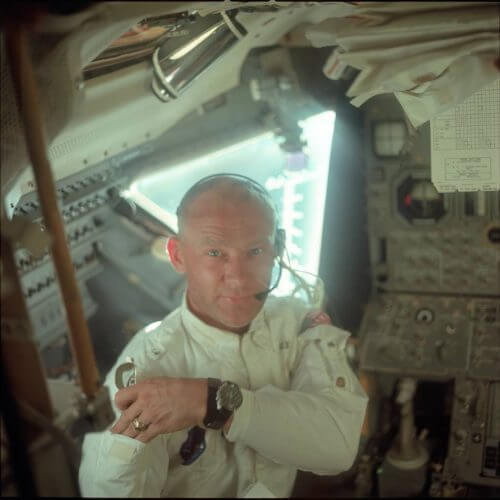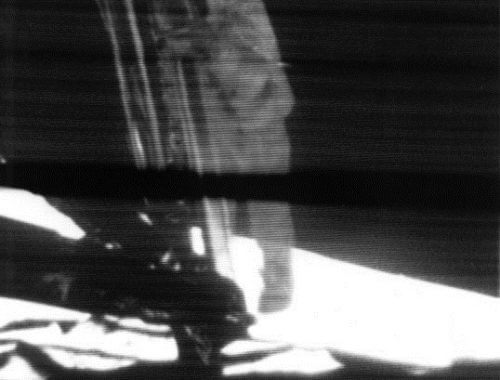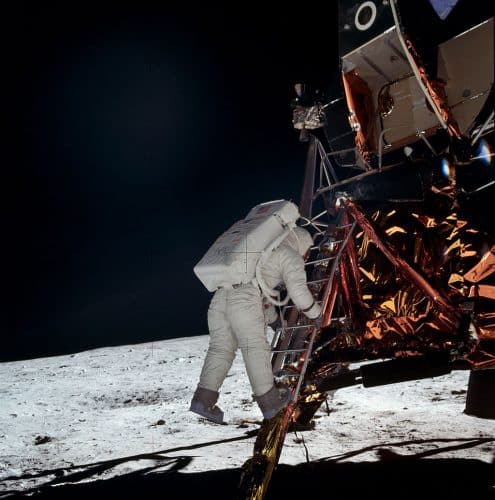
July 1969. A little more than eight years since the flights of Yuri Gagarin and Alan Shepherd, followed by President Kennedy's challenge to land men on the moon before the end of the decade and return them safely.
Only seven months have passed since NASA's bold decision to send Apollo 8 all the way to the moon on the first manned flight of the massive Saturn V rocket.
Summary of the first part: On the morning of July 16, astronauts Neil Armstrong Buzz Aldrin and Michael Collins sit atop the Saturn rocket during the complex launch of Launch 39A at the Kennedy Space Center. The three-stage rocket, which stands 110 meters high and uses 3.4 tons of fuel that will propel it into space and into history. At 9:32 am, the engines fired and Apollo 11 cleared the tower. After about 12 minutes, the team is in Earth orbit. After half an orbit, Apollo 11 receives permission to move to a lunar injection orbit.
The earth is getting smaller
The team made a planned television broadcast from an altitude of about 150,000 kilometers, showing the Earth getting smaller, as Armstrong described in detail the appearance of the planet. He then panned the camera into the cabin to show the astronauts and their food pantries to viewers, concluding with the mission patches on their spacesuits. The broadcast lasted 35 minutes. The crew members then went to bed for their second night in space, when the control center did not have to make the course correction the next day because the course they were flying was accurate.
In Houston, astronaut Frank Burman and flight crew manager Christopher Kraft held a press conference about Luna. 15 NASA managers were concerned that Luna 15 was orbiting the moon and its destination was still unclear, and feared that it would try to interfere in some way with the Apollo 11 mission. Borman visited Moscow in early July and met with the president of the Soviet Academy of Sciences Mstislav Kaldish. Taking advantage of the new acquaintance, Borman called Kaldish and expressed NASA's concern. Kaldish assured Borman that Luna 15 would not interfere with Apollo 11 and in an unprecedented action in space relations between the Americans and the Soviets, he gave Borman the details of the exact trajectory of Luna 15 and announced that it would remain in orbit around the moon for two days.
The main activity on Apollo 11's third day in space was the first launch of the landing vehicle - the Eagle on live television. Armstrong described the status of the docking mechanism, “Mike [Collins] must have done a smooth job on that docking. No sign of damage to the spacecraft. A compliment to Collins' excellent flying skills. When they opened the hatch to the eagle, the lights turned on automatically, and from the control room they said: "How about this? the size of a refrigerator. Aldrin floated into the Eagle, taking the television camera with him, and gave viewers a guided tour of all its systems, as well as the astronauts' helmets and backpacks. The broadcast lasted one hour and 36 minutes, after which Aldrin and Armstrong returned to Columbia and closed the door. A short time later, Apollo 11 passed into the influence of the moon's gravitational field, at a distance of 344 thousand km from the earth and 62,650 km from the moon. The team members went to sleep for the third time.

Shortly after waking up for their fourth day in space, Apollo 11 entered the shadow of the moon. They could see the surface of the moon illuminated by the earth, and for the first time they could see stars and constellations clearly. Backup astronaut Fred Hayes in the control room read the morning news to the crew members. An interesting item was that in reporting on the mission, the Soviet newspaper Pravda called Armstrong the "Tsar of the Ship". The Soviet press indicated that Luna 15 would accomplish everything that any previous Luna spacecraft had done, the first public hint that the mission would attempt to return samples from the Moon. Armstrong provided the following description of the moon, which the astronauts saw for the first time:
"The view of the moon is really spectacular. It fills about three quarters of the Columbia window and of course, we can see the entire circumference of the moon, although part of it is in total shadow because most of this area is illuminated by the light of the Earth. This view is worth the price of the trip.” Armstrong concluded.
Shortly thereafter, as had happened to Apollo 8 and 10 before it, Apollo 11 passed behind the Moon and all communications with Earth ceased. Eight minutes later, they fired the engine for six minutes to enter an elliptical orbit called Lunar Orbiter-1 (LO-I1). As Apollo 11 emerged back from behind the Moon, the crew members first saw the Earth's sunrise over the Moon, and Aldrin reported Mission Cestus to the control room. "The engine start-up went as planned, and everything looks good." A few minutes later, the astronauts got their first look at the landing site, but the landing date was not until the next day, when the sun would rise over the landing site, and the low angle would provide the best lighting for the landing. Upon arriving at the landing site, Armstrong commented: "It looks pretty similar to the pictures, but just like there's a difference between watching a football game on TV and reality, there's no substitute for being there."
During the second orbit of the moon, the astronauts photographed the view of the moon on its near side. At the end of the orbit, and again when they were over the far side of the moon, they fired the engine again for 12 seconds into the LOI-2 orbit, to make the orbit circular. Armstrong and Aldrin entered the Eagle a second time to start operating the device, and transfer equipment such as cameras to it. Aldrin reported that he could see the entire landing site when they passed over it. They returned to Columbia and for the first time entered a night's sleep in orbit around the moon. It was also the last night before the first landing attempt the next day.
A day later, Armstrong and Aldrin boarded the lunar lander and began the descent, while Collins remained orbiting the moon in the Columbia Command Module.
July 20, 1969 - a big step for humanity

Collins later writes that the Eagle is "the strangest looking device I ever saw in the sky", but it proved its worth.
When it came time to land the eagle in the calm sea, Armstrong had to improvise as he manually flew the spacecraft over a rocky terrain. During the final seconds of the descent, the Eagle's computer sounded alarms.
Turns out it was simply because the computer was trying to do too many things at once but as Aldrin would later say. "Unfortunately, it came when we didn't want to deal particularly with problems of this kind."
When the lunar module lands at 16:17 PM EST, it has only thirty seconds of fuel left. Armstrong broadcast: "Houston, peaceful base here, relieved." All the mission control workers erupted with joy and one of the controllers tells the team "There are a bunch of people here who were about to turn blue. We are breathing again.”
Armstrong would later confirm that the landing was his biggest worry, saying "all the unknowns were raging", "we had a thousand things to worry about".
At 22:56 PM EDT, Armstrong was ready to descend the ladder and set the first human foot on another world. In front of more than half a billion people watching on television, he stepped off the ladder and declared "This is one small step for man, one giant leap for humanity."
Aldrin soon joins him, offering a simple but powerful description of the lunar surface: "a glorious wasteland." They explore the surface for two and a half hours during which they were mainly engaged in collecting samples and taking photographs.

They left behind an American flag, a sign honoring the members of the Apollo 1 crew who perished, and a plaque on one of the eagle's legs that reads: "Here people from planet Earth set foot on the moon, July 1969 'We came in peace in the name of all mankind.'
Armstrong and Aldrin took off and rendezvoused with Collins and Columbia. Collins later says that "for the first time," he "really felt that 'we're going to pull this thing off.'"
Apollo 11 lands in the sea near Hawaii on July 24. Kennedy's challenge was realized. Humans from Earth walked on the moon and returned home safely.
In an interview years later, Armstrong praised the "hundreds of thousands of people who were behind the project. "Every guy who did tests, worked on building parts of the launcher and so on, man or woman, they all did everything, if something went wrong, it wouldn't be their fault."
At a press conference after the landing, Armstrong called the flight "the beginning of a new era," while Collins talked about future trips to Mars. As mentioned, NASA is talking about a manned journey to Mars in the thirties of the 21st century. I wonder if he will get to witness its realization.
Over the next three and a half years, ten astronauts would follow in their footsteps. Gene Cernan, commander of the last Apollo mission, ended his stay on the surface of the moon with these words: "We leave the moon as we came with God's help, so that we may return in peace and hope for all mankind."
This article also uses the following excerpt from the NASA website In addition toNASA article used בThe first part of the article
More of the topic in Hayadan:

One response
A monumental tribute to Apollo, to its connection to the space race, to NASA for its entire history, and especially to the Apollo 11 landing, to Neil Armstrong and Buzz Aldrin can be found in this series, in four parts, in English only (of course). The series is presented by one Bill Whittle, who I am going to follow more closely.
the first chapter
https://www.youtube.com/watch?v=1L_11fggn0Q